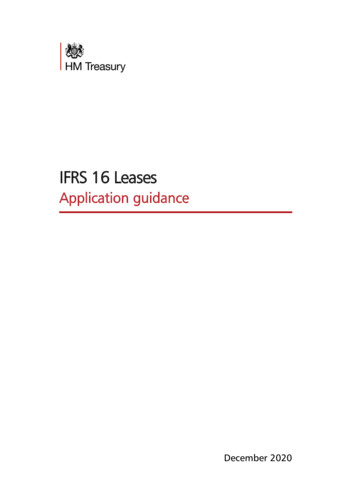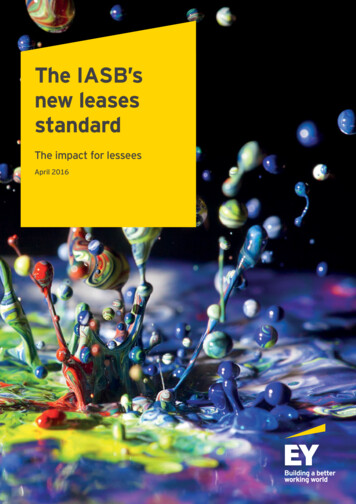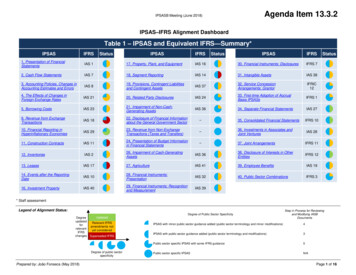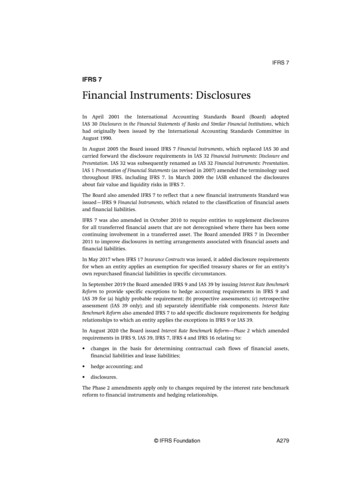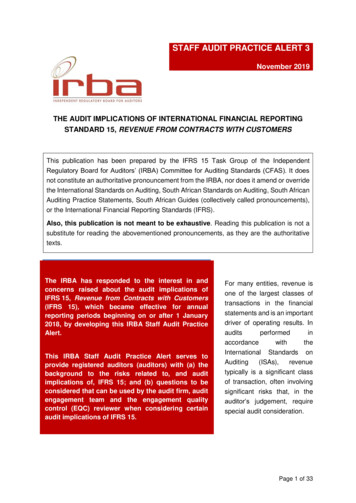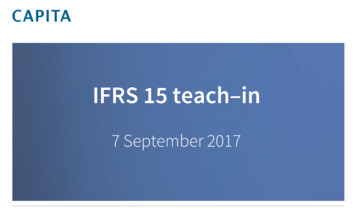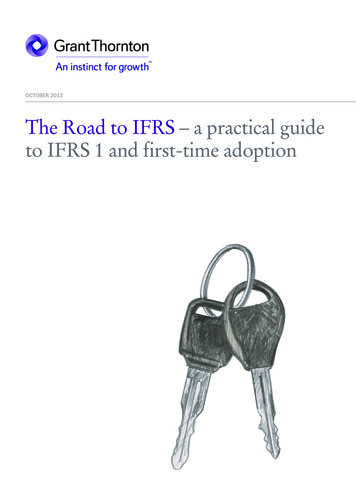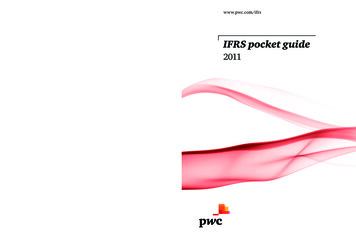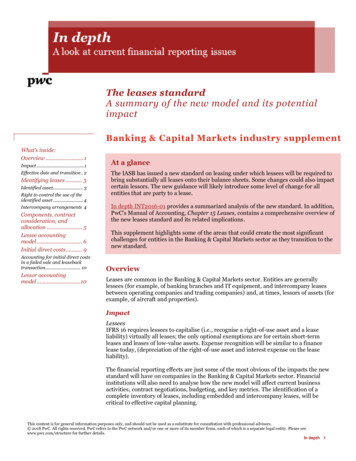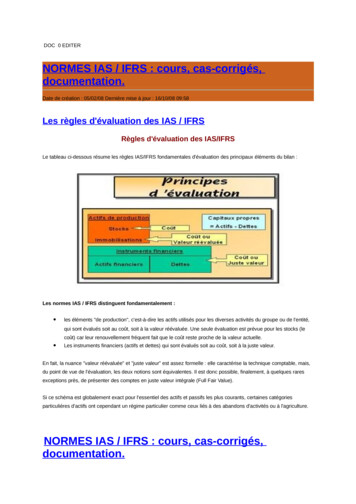
Transcription
IFRS 16 - LEASESInformation sessionFebruary 21, 2019
Caution Regarding Forward-lookingInformationThis presentation includes forward-looking statements within the meaning of applicable securities laws. Forward-lookingstatements relate to analyses and other information that are based on forecasts of future results and estimates of amountsnot yet determinable. These statements may involve, but are not limited to, comments relating to preliminary results,guidance, strategies, expectations, planned operations or future actions. Forward-looking statements are identified usingterms and phrases such as “preliminary”, “anticipate”, “believe”, “could", “estimate”, “expect”, “intend”, “may”, “plan”,“predict”, “project”, “will”, “would”, and similar terms and phrases, including references to assumptions.Forward-looking statements, by their nature, are based on assumptions, including those described herein and are subject toimportant risks and uncertainties. Forward-looking statements cannot be relied upon due to, amongst other things, changingexternal events and general uncertainties of the business. Actual results may differ materially from results indicated inforward-looking statements due to a number of factors, including without limitation, our ability to successfully achieve orsustain positive net profitability or to realize our initiatives and objectives, industry, market, credit, economic and geopoliticalconditions, energy prices, currency exchange, competition, our dependence on technology, cybersecurity risks, our ability tosuccessfully implement appropriate strategic initiatives or reduce operating costs, our ability to successfully integrate andoperate the Aeroplan loyalty business following its acquisition from Aimia Inc. and to successfully launch our new loyaltyprogram, our ability to preserve and grow our brand, airport user and related fees, high levels of fixed costs, our dependenceon key suppliers including regional carriers, employee and labour relations and costs, our dependence on Star Alliance andjoint ventures, interruptions of service, environmental factors (including weather systems and other natural phenomena andfactors arising from man-made sources), our ability to pay our indebtedness and maintain liquidity, pension issues, limitationsdue to restrictive covenants, pending and future litigation and actions by third parties, our ability to attract and retainrequired personnel, war, terrorist acts, casualty losses, changes in laws, regulatory developments or proceedings, epidemicdiseases, insurance issues and costs, as well as the factors identified in Air Canada's public disclosure file available atwww.sedar.com and, in particular, those identified in section 18 “Risk Factors” of Air Canada’s 2018 MD&A.The forward-looking statements contained or incorporated by reference in this presentation represent Air Canada'sexpectations as of the date of this presentation (or as of the date they are otherwise stated to be made) and are subject tochange after such date. However, Air Canada disclaims any intention or obligation to update or revise any forward-lookingstatements whether because of new information, future events or otherwise, except as required under applicable securitiesregulations.This presentation also includes certain non-GAAP financial measures used by Air Canada to provide readers with additionalinformation on its financial and operating performance. Such measures are not recognized measures for financial statementpresentation under GAAP, do not have standardized meanings, may not be comparable to similar measures presented by otherentities and should not be considered a substitute for or superior to GAAP results.2
IFRS 16 LeasesImportant Notice The information relating to International Financial Reporting Standards 16 Leases("IFRS 16") is provided solely for the purpose of allowing investors and others toobtain a better understanding of the impact of IFRS 16 on certain of Air Canada’saccounting policies and financial results for the year ended December 31, 2018.Readers are cautioned that it may not be appropriate to use such information forany other purpose. The accounting policy changes identified in this presentation should not beconsidered as complete or final as further changes, or other effects and otherpolicy differences may be identified. In addition, the information provided reflectsAir Canada’s assumptions, estimates and expectations as of February 14, 2019,all of which are subject to change. Circumstances may arise, including changes inIFRS, regulations or economic conditions, which could change these assumptions,estimates or expectations or the information provided. All figures presented are preliminary and subject to the completion of an externalaudit or review. Air Canada cannot provide any further estimates of the future impact of adoptingIFRS 16 at this time. For additional information, refer to Air Canada’s 2018 MD&A dated February 15,2019, available on Air Canada’s website at www.aircanada.com or on SEDAR atwww.sedar.com.3
IFRS 16 Leases - Agenda IFRS 16 overview Impact on Air Canada – Key accounting policy changes Estimated adjustments on adoption of IFRS 16– Consolidated Statement of Financial Position –January 1, 2018– Consolidated Statement of Operations – 2018– Key Financial and Non-GAAP Measures Appendix– Contractual Commitments as at December 31, 2018– Non-GAAP Measures4
IFRS 16 OverviewEffective for annual periods beginning on orafter January 1, 2019 Guidance applies to leases of property, plant and equipment Core principle is that a lessee recognizes assets and liabilities forall leases with a lease term of more than 12 months –exemptions for short-term leases and low-value assets A contract contains a lease if:– there is an identified asset, and– the contract conveys the right to control the use of theidentified asset for a period of time in exchange forconsideration Full retrospective application is optional– Air Canada is adopting IFRS 16 with the full retrospectiveapproach with restatement of 2018 comparatives5
IFRS 16 OverviewGeneral Impacts of IFRS 16 No longer distinguish between finance lease (on balance sheet)and operating lease contracts (off-balance sheet) Instead, lessees will recognize a right-of-use asset and acorresponding lease liability for almost all lease contracts Impact is substantial increase in recognized financial liabilitiesand assets for companies that have significant lease contractsthat are currently accounted for as operating leasesU.S. GAAP IFRS 16 generally aligned with equivalent U.S. GAAP standard Key differences include method of adoption, transition andincome statement presentation of former operating leases. UnderU.S. GAAP, while the lessee will report an asset and a liabilityrelated to all leases on its balance sheet (like IFRS), the Day Twoaccounting for operating leases will generally continue to producea straight-line total lease expense6
IFRS 16 OverviewMeasurement Initial measurement is:– Lease liability Present value of lease payments Lease payments should be discounted using the interest rate implicit inthe lease, and if this cannot be readily determined, the lessee’sincremental borrowing rate is used Includes non-cancellable lease payments including payments to be madein optional periods if reasonably certain to exercise lease extension Does not include variable lease payments other than those that dependon an index or rate– Right-of-use asset lease liability plus estimate of anyprovisions the lessee will owe for return conditions on theleased asset7
IFRS 16 OverviewOngoing Accounting Lease liability is measured in subsequent periods using theeffective interest rate method The right-of-use asset is depreciated over the lease term– The carrying amount of the asset and liability will no longerbe equal in subsequent periods– In general, the asset will be below the carrying value of thelease liability as the asset will be depreciated on a straightline basis while the effective interest rate method on thelease liability results in a decreasing lease expensethroughout the lease term8
IFRS 16 OverviewOngoing Accounting (continued) Lease extensions – change in lease liability with an adjustmentto the right-of-use asset Modification to a lease – treatment will depend on modification:– decrease or increase in scope: adjust lease liability and rightof-use asset, with p&l impact if a decrease in scope– increase in scope with increase in lease consideration:separate lease contract9
Accounting Policy SelectionTransition – Full retrospective versus modified retrospective Air Canada will apply IFRS 16 retrospectively to each priorreporting period Enables full comparative financial informationTransition – Practical expedients Air Canada will elect to adopt the practical expedients, including:– The option to ‘grandfather’ the assessment of which contractsare leases– Applying the recognition exemption for short term leases andcontracts that for which the underlying asset has a low value10
Accounting Policy SelectionAircraft leases – Maintenance provision Maintenance provision recorded for all aircraft leases as a maintenanceexpense over the term of the lease. Under previous IFRS, no provisionwas recorded for finance-leased or regional CPA aircraft Any changes to the maintenance provision will be recorded with acorresponding adjustment to the right-of-use asset, and depreciated overthe remaining lease term. Under previous IFRS, a change in maintenanceprovision is taken immediately to income as maintenance expenseadjustmentAircraft leases – Sale-leaseback accounting Previously reported sale and leaseback transactions are restated in linewith IFRS 16 guidance which generally results in lower gains on sale anda lower asset value Sale and leaseback gains are recorded to the extent of the asset sold;remainder is recorded as an adjustment to the right-of-use asset11
Impact on Air CanadaAircraft leases – Componentization Right-of-use assets are to be accounted for under IAS 16Property, Plant and Equipment Aircraft recorded as right-of-use assets will have the sameaccounting policies as directly owned aircraft– Right-of-use assets will be componentized and depreciatedover the lease term– Any qualifying maintenance events will be capitalized anddepreciated over the lesser of the lease term and expectedmaintenance life– Under previous IFRS, the policy for operating leased aircraftwas to expense maintenance as incurred unless reducinglease return conditions12
Accounting Policy SelectionRegional leases CPA Aircraft are leased assets to Air Canada and the same accountingpolicies and transitional considerations as Air Canada direct leases will beappliedProperty leases Air Canada has leases related to airport terminal operations and otherreal estate leases Terminal operations space generally have effective substitution rights inthe hands of the lessor and therefore not considered lease contractsunder IFRS 16 Leases with reciprocal termination rights with notice period of less than12 months would be considered short-term leases and are excluded fromrecognition under the practical expedient Airport terminal contracts with variable lease payments are also excluded,since variable lease payments, other than those based on an index orrate, are excluded from measurement13
Impact on Air CanadaScope of Impact on Air Canada: Right-of-use assets and leaseliabilities upon IFRS 16 adoptionAircraft leases 126 aircraft under operating leases at December 31, 2018Regional partner aircraft leases 132 aircraft at December 31, 2018 used by regional carriersproviding services to Air Canada under capacity purchaseagreements that qualify as IFRS 16 leasesProperty leases 46 leases representing dedicated space in Air Canada’s hublocations of Toronto, Montreal and Vancouver, lease contracts onbuilding space for offices, airport and maintenance operations,Maple Leaf Lounges and land leases14
Impact on Air CanadaIncome statement impacts Elimination of aircraft rent and building rent for those contracts which arerecognized as leases, and instead will be replaced by– Amortization of the right-of-use asset in the same line item as other–Property & EquipmentInterest expense on the lease liability as part of finance costs Maintenance expense is expected to decrease as qualifying maintenanceevents will now be capitalized as part of the right-of-use asset and depreciated Offsetting this, maintenance provisions for end-of-lease return obligations forall aircraft right-of-use assets will be recorded as a maintenance expense overthe lease term Regional airlines expense is expected to decrease to the extent aircraft rent isremoved and recorded in depreciation and interest expense outside of theRegionals airlines expense Since all the aircraft leases are denominated in U.S. dollars, there may beadditional volatility in the foreign exchange recognized in the incomestatement due to the revaluation of the lease liabilities and maintenanceprovisions to the rate of exchange in effect at the date of the balance sheet15
Estimated Expected Adjustments to the Statement ofFinancial Position as at January 1, 2018 under IFRS 16December 31,2017 aspreviouslyreported(Canadian dollars in millions)Accounts receivableDeposits and other assetsProperty and equipmentDeferred income taxesTotal assets Accounts payable and accrued liabilitiesCurrent portion of long-term debt and leasesTotal current liabilitiesLong-term debt and lease liabilitiesMaintenance provisionsOther long-term liabilitiesTotal liabilities Retained earningsShareholders' equity Total liabilities and shareholders' equity 602,5543,42217,782Air Canadaaircraft 195)1,654Regionalaircraft ty leases ExpectedJanuary 1, 2018as restated16013173 1212198210(37)(37)173 7,7231,9282,79620,51916
Estimated Expected Adjustments to the 2018 ConsolidatedStatement of Operations under IFRS 16(Canadian dollars in millions)Total revenuesDecember 31,2018 as previouslyreported 18,065Air Canadaaircraft -Regionalaircraft -Property leases -ExpectedDecember 31,2018 as restated 18,065Regional airlines expense2,842-(323)-2,519Aircraft maintenanceDepreciation, amortization and (73)(70)19(51)(4)1(3)231(191)40Aircraft rentAll other (including property rent)Total operating expensesOperating incomeInterest expenseForeign exchange and otherTotal non-operating expenseIncome before income taxesincome tax expenseNet income 17
Key Financial and Non-GAAP Measures under IFRS 16(Canadian dollars in millions, except where indicated)Revenue2018 restated underIFRS 16 Operating expense, before depreciation and aircraft rentDepreciation and aircraft rentOperating expense18,0652018 as underprevious IFRS 18,065Change rating income 1,499 1,174 325EBITDA (EBITDAR) 3,222 2,851 371EBITDA (EBITDAR) Margin %Adjusted pre-tax income17.8% ROIC %Leverage ratioFree cash flow 1,03915.8% 9522.0 pp 8714.5%12.6%1.9 pp1.62.1(0.5)1,322 791 53118
AppendixContractual Obligations as at December 31, 2018for IFRS 16 Lease Obligations(Canadian dollars in onal PrincipalAir Canada aircraft 4113373391,0813,2651198865514185449Regional CPA aircraft847056443026310Property leases1414131212199264Regional CPA aircraftProperty leasesTotal principal obligations403 310 230 162 162 Additional InterestAir Canada aircraftTotal interest obligations 217 172 134 107 83 310 1,023Total lease obligations 810 676 545 444 422 1,391 4,288Revised total long-term debtand lease obligationsPrincipal 662,490 1,552 1,634 1,785 982 2,043 4,519 12,515 23InterestObligations related to leasesnot recorded as IFRS 16 leaseobligations28191387 9819
AppendixNon-GAAP Measures under IFRS 16(Canadian dollars in millions)GAAP operating income2018 restated underIFRS 16 1,4992018 as underprevious IFRS 1,174 Change 325Add back (as reflected on the consolidated statementof operations):Depreciation, amortization and impairment1,7171,0806376518(512)Depreciation, amortization and impairment-38(38)Aircraft rent-41(41)Aircraft rentAdd back (included in Regional airlines expense):EBITDAR 3,222 2,851 37120
AppendixNon-GAAP Measures under IFRS 16(Canadian dollars in millions, except where indicated)Income before income taxes2018 restatedunder IFRS 16 2018 underprevious IFRS231 405 Change (174)Remove:Foreign exchange lossNet financing expense relating to employee benefitsLoss on financial instruments recorded at fair valueGain on debt settlements and modificationsLoss on disposal of assetsAdjusted pre-tax income Interest expenseImplicit interest on operating leasesAdjusted pre-tax income before interest 5783172615050-11-(9)(9)-188188-1,039 952 87567331236-274(274)1,606 1,557 49Invested capital:Average long-term debt and finance lease obligations9,6496,3863,263Average shareholders’ equity, net of excess cash1,3752,065(690)-3,913(3,913)Capitalized operating leasesInvested capitalReturn on invested capital (%) 11,02414.5% 12,36412.6% (1,340)1.9%21
AppendixNon-GAAP Measures under IFRS 16December 31, 2018under IFRS 16(Canadian dollars in millions, except where indicated)Total long-term debt and leases 8,873December 31, 2018under previous IFRS 6,197 Change 2,676Current portion of long-term debt and leases1,048455593Total long-term debt and leases,including current portion9,9216,6523,269(4,707)(4,707)-Less cash, cash equivalents and short-term investmentsNet debt Capitalized operating leases5,214 -1,945 3,9133,269(3,913)Adjusted net debt 5,214 5,858 (644)EBITDAR 3,222 2,851 371Leverage ratio1.62.1(0.5)22
AppendixNon-GAAP Measures under IFRS 16(Canadian dollars in millions)Net cash flows from operating activities2018 restated underIFRS 16 Additions to property, equipment and intangible assets, netof proceeds from sale-leaseback transactionsFree cash flow3,4652018 as underprevious IFRS (2,143) 1,3222,695Change (1,904) 791770(239) 53123
Aircraft leases -Sale-leaseback accounting Previously reported sale and leaseback transactions are restated in line with IFRS 16 guidance which generally results in lower gains on sale and a lower asset value Sale and leaseback gains are recorded to the extent of the asset sold;
